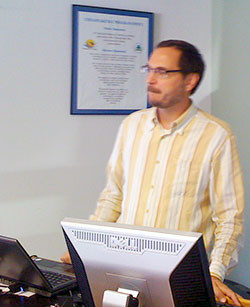Discussion following Bob Wood's seminar on Climate forcing of fisheries production in Chesapeake Bay over the last century
Bill Dennison ·This blog post discusses the seminar given by Bob Wood of the Cooperative Oxford Laboratory, at the IAN Seminar Series on August 26, 2010.

There was a lively discussion following Bob Wood's seminar. The observation was made that several of Bob's slides were 'Tufte' approved, in that they contained a large amount of content, with little 'chart-junk'. The talk was characterized as being both data-rich and idea-rich.
The question of how the Atlantic Multidecadal Oscillation (AMO), which led to variations in flow, would be manifested as changes in striped bass or menhaden abundance was discussed. Bob made the point that the winters with frequent nor'easters typically had good striped bass recruitment and the winters dominated by a Gulf of Mexico high typically had good menhaden recruitment. The AMO explained roughly half of the annual variation in the stripers and menhaden, and it was noted that this clearly has implications with regard to climate change and variability.
The question of what the functional fish response is to the AMO does not have clear answers. Bob did point out that the 100+ year data set that he used provided a weight of evidence argument for a strong signal, but the actual mechanisms were elusive. He did provide a scenario for how the striped bass could benefit from nor'easters; 1) nor'easters provide good flow in late winter/early spring which means the prey items for juvenile stripers, particularly the copepod Eurytemora affinis, are abundant, and 2) the prey are spread out throughout the lower salinity regions of Chesapeake Bay. The scenario for menhaden thriving in winters with the Gulf of Mexico high dominating the regional weather patterns was that 1) menhaden larvae, which are produced offshore, are 'injected' into Chesapeake Bay with the dry southwesterly winds and 2) the dry weather leads to fewer zooplankton that eat phytoplankton, allowing the opportunity for more menhaden food as they lose their juvenile teeth and begin sieving phytoplankton from the water column.
Bob was asked about the designation of the oligohaline/mesohaline turbidity zone (OMTZ) vs. the well established estuarine turbidity maximum (ETM). Bob responded that the OMTZ, while centered on the ETM, was a broader region, with higher and lower salinities than the ETM to account for the region that the striped bass young of the year inhabited.
The relationship between AMO and the food web leads to speculation that the AMO may also be correlated to various water quality features, such as the magnitude of the so-called 'dead zone'; volume or area of the Bay in which water contains low (hypoxia) or essential no (anoxia) oxygen. Since flow, nutrient inputs and wind direction/velocity play important roles in dissolved oxygen, the AMO could affect dissolved oxygen levels, for example.
The issue of the influence of climate change on AMO patterns was discussed. While regional climate change projections are for more flow (warmer, wetter winters), the AMO relationships with striped bass and menhaden may break down. Warmer, wetter winters not caused by frequent nor'easters could lead to different patterns, since the actual mechanisms that lead to the statistical correlations are not known at this time. One of the points that the analysis demonstrated was the importance of phytoplankton and zooplankton monitoring in Chesapeake Bay. The zooplankton program was eliminated several years ago and the phytoplankton monitoring program is under threat, but the important linkage that these trophic levels have with fisheries resources make these data particularly crucial.
The management implications of these findings were discussed. The stock assessment approach that currently dominates fisheries management does not take in account the multi-decadal oscillations (60-70 year regime shifts) that the AMO/fisheries analyses reveal. An upward trending period could be a time to relax some of the fisheries restrictions, and alternatively, a downward trending period would need to have a more stringent approach to fisheries restrictions.
Further details of this work can be found in a co-authored paper in the Can. J. Fish. Aquat. Sci. 66(3): 496–508 (2009)
About the author
Bill Dennison

Dr. Bill Dennison is a Professor of Marine Science and Vice President for Science Application at the University of Maryland Center for Environmental Science.

